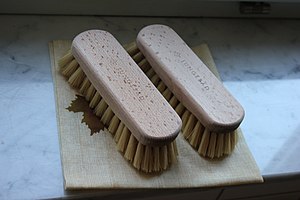Difference between revisions of "Oil dispersion bath"
| [checked revision] | [checked revision] |
(File instead of Datei) |
(Brushes for the oil dispersion bath) |
||
| Line 5: | Line 5: | ||
=== Implementation === | === Implementation === | ||
| − | [[File:Jungebad Bürsten.JPG|thumbnail|300x300px| | + | [[File:Jungebad Bürsten.JPG|thumbnail|300x300px|Brushes for the oil dispersion bath|link=Special:FilePath/Jungebad_Bürsten.JPG]]The oil dispersion apparatus is installed in the water inlet of the tub. The incoming water flows through a pear-shaped chamber, the shape of which creates a vortex. A pipette runs from the top of the oil tank into the center of the vortex. The vacuum created there sucks in either air or oil, depending on how full the oil container is, and thus mixes with the water in finely atomized small quantities. The water-oil mixture flows out of the apparatus into the tank in the form of a funnel. |
The temperature of the water should be approximately the same as the body temperature of the person bathing, feeling neither hot nor cold. The bath is usually done unclothed. | The temperature of the water should be approximately the same as the body temperature of the person bathing, feeling neither hot nor cold. The bath is usually done unclothed. | ||
Revision as of 02:03, 22 September 2021
The oil dispersion bath (or Junge bath) is a bath therapy of anthroposophic medicine. It was developed by Werner Junge, inspired by statements of Rudolf Steiner. By purely physical principles a mixture of oil and water is achieved. For this purpose, a swirling apparatus made of glass is flowed through by the incoming bath water. The pear shape of the glass creates a vortex in the center of which oil flows in through a fine inlet. The oil is atomized into very fine droplets and forms a dispersion with the water, which remains stable for the duration of the bath and for a certain time beyond. The oils used as a base are various vegetable oils such as olive or linseed oil, to which essential oils or other additives such as metals are added. Often the oil dispersion bath is performed by a bath therapist who performs a brush massage. The temperature of the bath water should be approximately equal to the body heat and should not provide a heat or cold stimulus. After the bath there is a rest about the length of the bath. Wrapped in a cotton cloth and (wool) blankets, the aim is to warm the body by stimulating its own heat. The oil dispersion bath is used in addition to other therapeutic measures, especially in chronic diseases.
History
The oil dispersion bath was developed by Werner Junge in 1937 as a medical therapy. Based on a note by Rudolf Steiner on the treatment of sugar dysentery (diabetes mellitus) (I. Medical Course, 1920, Dornach) "on the effect of finely atomized oils,"[1] he designed the first oil dispersion bath apparatus. [2] The name oil dispersion bath goes back to the anthroposophical physician Hans Klett, who called the oil-water mixture dispersion.[3] In 2001, bath therapists joined forces in the International Association for Oil Dispersion Bath Therapy according to Werner Junge.[4]
Implementation
The oil dispersion apparatus is installed in the water inlet of the tub. The incoming water flows through a pear-shaped chamber, the shape of which creates a vortex. A pipette runs from the top of the oil tank into the center of the vortex. The vacuum created there sucks in either air or oil, depending on how full the oil container is, and thus mixes with the water in finely atomized small quantities. The water-oil mixture flows out of the apparatus into the tank in the form of a funnel.
The temperature of the water should be approximately the same as the body temperature of the person bathing, feeling neither hot nor cold. The bath is usually done unclothed.
If the bath is performed by a therapist, a brush massage with a specific sequence of brush strokes is performed.
After the bath, there should be a post-bath rest about the length of the bath. The person bathing is wrapped in a cotton cloth and woolen blankets, so that a kind of moist warm full body wrap takes place. During the after-rest, there is often a reactive increase in body temperature. It should not feel cool in the rest wrap, nor should the person sweat.
The bath can be performed 1-3x per week, exceptionally more often. Partial baths are also possible.


